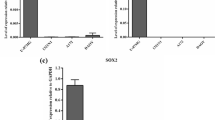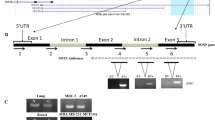Abstract
Long non-coding RNAs are manifested as a new paradigm of molecular effectors in a wide range of human diseases. Human SOX2 overlapping transcript (SOX2OT) gene can generate six lncRNA transcript variants which are functionally assumed to be correlated with cellular differentiation and carcinogenesis. However, the circumstances determining expressional and functional differences between SOX2OT transcript variants remain to be explored. Here, we studied the expression of all SOX2OT transcript variants specifically in five human cancer cell lines by real-time RT-PCR. Changes of the new SOX2OT transcript variants expression were measured during the NT2 teratocarcinoma cell line neuronal-like differentiation and were compared to pluripotency regulators, SOX2 and OCT4A gene expressions. Surprisingly, we identified two new SOX2OT transcripts, named SOX2OT-7, SOX2OT-8 which lack exon 8. We discovered that beside active proximal and distal SOX2OT promoters, different cancer cell lines express high levels of some SOX2OT transcript variants differentially by alternative splicing. Significantly, both SOX2OT-7 and SOX2OT-8 are highly expressed in human cancer cell lines coinciding with SOX2, one of the pluripotency regulators. Our results revealed that SOX2OT-7 is almost the most abundant form of SOX2OT transcript variants in the examined cancer cell lines particularly in NT2 teratocarcinoma cell line where its expression falls upon neuronal-like differentiation similar to SOX2 and OCT4A. We suggest that at least some of SOX2OT transcripts are significantly associated with cancer and stem cell related pathways.




Similar content being viewed by others
References
Birney E, Stamatoyannopoulos JA, Dutta A, Guigó R, Gingeras TR, Margulies EH, Weng Z, Snyder M, Dermitzakis ET, Thurman RE (2007) Identification and analysis of functional elements in 1 % of the human genome by the ENCODE pilot project. Nature 447(7146):799–816
Carninci P, Kasukawa T, Katayama S, Gough J, Frith M, Maeda N, Oyama R, Ravasi T, Lenhard B, Wells C (2005) The transcriptional landscape of the mammalian genome. Science 309(5740):1559–1563
Consortium EP (2004) The ENCODE (ENCyclopedia of DNA elements) project. Science 306(5696):636–640
Consortium IHGS (2004) Finishing the euchromatic sequence of the human genome. Nature 431(7011):931–945
Amaral PP, Mattick JS (2008) Noncoding RNA in development. Mamm Genome 19(7–8):454–492
Kapranov P, Cheng J, Dike S, Nix DA, Duttagupta R, Willingham AT, Stadler PF, Hertel J, Hackermüller J, Hofacker IL (2007) RNA maps reveal new RNA classes and a possible function for pervasive transcription. Science 316(5830):1484–1488
Ponting CP, Oliver PL, Reik W (2009) Evolution and functions of long noncoding RNAs. Cell 136(4):629–641
Chen L-L, Carmichael GG (2010) Decoding the function of nuclear long non-coding RNAs. Curr Opin Cell Biol 22(3):357–364
Kaikkonen MU, Lam MT, Glass CK (2011) Non-coding RNAs as regulators of gene expression and epigenetics. Cardiovasc Res 90(3):430–440
Taft RJ, Pang KC, Mercer TR, Dinger M, Mattick JS (2010) Non-coding RNAs: regulators of disease. J Pathol 220(2):126–139
Wang X, Song X, Glass CK, Rosenfeld MG (2011) The long arm of long noncoding RNAs: roles as sensors regulating gene transcriptional programs. Cold Spring Harb Perspect Biol 3(1):a003756
Wilusz JE, Sunwoo H, Spector DL (2009) Long noncoding RNAs: functional surprises from the RNA world. Genes Dev 23(13):1494–1504
Fejes-Toth K, Sotirova V, Sachidanandam R, Assaf G, Hannon GJ, Kapranov P, Foissac S, Willingham AT, Duttagupta R, Dumais E (2009) Post-transcriptional processing generates a diversity of 5′-modified long and short RNAs. Nature 457(7232):1028–1032
Fantes J, Ragge NK, Lynch S-A, McGill NI, Collin JRO, Howard-Peebles PN, Hayward C, Vivian AJ, Williamson K, van Heyningen V (2003) Mutations in SOX2 cause anophthalmia. Nat Genet 33(4):461–463
Andrew T, Maniatis N, Carbonaro F, Liew SM, Lau W, Spector TD, Hammond CJ (2008) Identification and replication of three novel myopia common susceptibility gene loci on chromosome 3q26 using linkage and linkage disequilibrium mapping. PLoS Genet 4(10):e1000220
Shahryari A, Rafiee MR, Fouani Y, Oliae NA, Samaei NM, Shafiee M, Semnani S, Vasei M, Mowla SJ (2014) Two novel splice variants of SOX2OT, SOX2OT‐S1, and SOX2OT‐S2 are coupregulated with SOX2 and OCT4 in esophageal squamous cell carcinoma. Stem Cells 32(1):126–134
Amaral PP, Neyt C, Wilkins SJ, Askarian-Amiri ME, Sunkin SM, Perkins AC, Mattick JS (2009) Complex architecture and regulated expression of the Sox2ot locus during vertebrate development. RNA 15(11):2013–2027
Hussenet T, Dali S, Exinger J, Monga B, Jost B, Dembelé D, Martinet N, Thibault C, Huelsken J, Brambilla E (2010) SOX2 is an oncogene activated by recurrent 3q26.3 amplifications in human lung squamous cell carcinomas. PLoS One 5(1):e8960
Askarian-Amiri ME, Seyfoddin V, Smart CE, Wang J, Kim JE, Hansji H, Baguley BC, Finlay GJ, Leung EY (2014) Emerging role of long non-coding RNA SOX2OT in SOX2 regulation in breast cancer. PLoS One 9(7):e102140
Hou Z, Zhao W, Zhou J, Shen L, Zhan P, Xu C, Chang C, Bi H, Zou J, Yao X (2014) A long noncoding RNA Sox2ot regulates lung cancer cell proliferation and is a prognostic indicator of poor survival. Int J Biochem Cell Biol 53:380–388
Atlasi Y, Mowla SJ, Ziaee SA, Gokhale PJ, Andrews PW (2008) OCT4 spliced variants are differentially expressed in human pluripotent and nonpluripotent cells. Stem Cells 26(12):3068–3074
Mattick JS, Makunin IV (2006) Non-coding RNA. Hum Mol Genet 15(suppl 1):R17–R29
Mercer TR, Dinger ME, Sunkin SM, Mehler MF, Mattick JS (2008) Specific expression of long noncoding RNAs in the mouse brain. Proc Natl Acad Sci 105(2):716–721
Shahryari A, Jazi MS, Samaei NM, Mowla SJ (2015) Long non-coding RNA SOX2OT: expression signature, splicing patterns, and emerging roles in pluripotency and tumorigenesis. Front Genet 6:196
Acknowledgments
This study was part of a PhD thesis financially supported by Golestan University of Medical Science (grant number: 92041130).
Author information
Authors and Affiliations
Corresponding author
Rights and permissions
About this article
Cite this article
Saghaeian Jazi, M., Samaei, N.M., Ghanei, M. et al. Identification of new SOX2OT transcript variants highly expressed in human cancer cell lines and down regulated in stem cell differentiation. Mol Biol Rep 43, 65–72 (2016). https://doi.org/10.1007/s11033-015-3939-x
Received:
Accepted:
Published:
Issue Date:
DOI: https://doi.org/10.1007/s11033-015-3939-x




